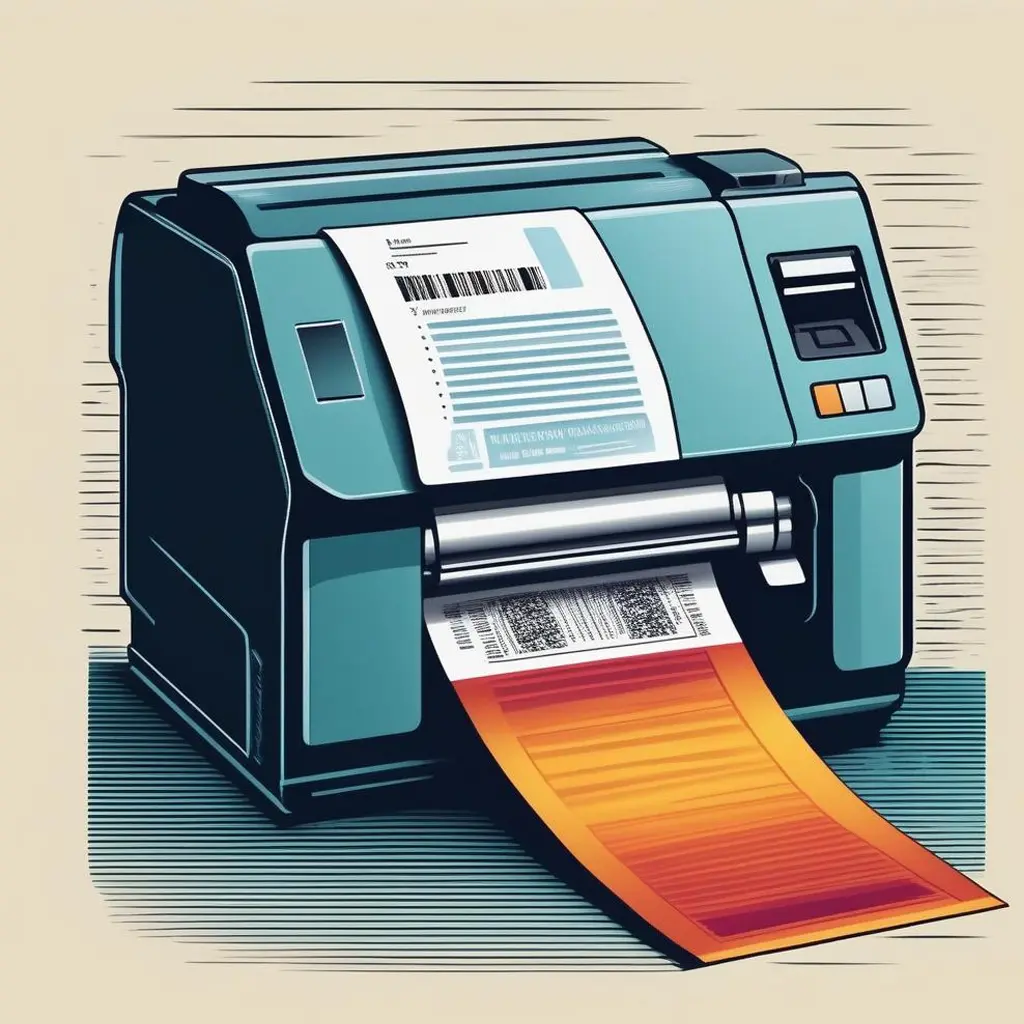
In the bustling world of retail, where every transaction counts, the humble receipt plays a vital role in documenting purchases and fostering customer satisfaction. But have you ever stopped to ponder the intricate components that make up these seemingly simple slips of paper? Join us on a journey as we delve into the anatomy of thermal receipts, exploring everything from the printers that bring them to life to the paper rolls that keep them rolling.
Components of Thermal Receipts
At the core of every thermal receipt lies the humble thermal paper roll, a seemingly simple yet indispensable component in the world of printing technology. These rolls are not mere paper; they are meticulously coated with a special chemical formulation that reacts to heat, transforming it into the text and images we see on receipts. This heat-sensitive coating acts as the catalyst, enabling thermal printers to produce prints swiftly and efficiently, without the need for traditional ink or toner cartridges.
Diverse Varieties
However, it’s crucial to note that not all thermal paper rolls are created equal. They come in various sizes, thicknesses, and formulations, each catering to specific printer models or application requirements. Some rolls are designed for high-speed printing, ideal for busy retail environments where efficiency is paramount. Others boast enhanced durability, capable of withstanding harsh conditions in industrial settings or outdoor use.
Choosing the Right Paper
Selecting the appropriate thermal paper roll is paramount to ensure optimal performance and longevity for your thermal printer. Consider factors such as roll size, paper thickness, and compatibility with your printer model. Additionally, for environmentally conscious businesses, there are eco-friendly options available, made from recycled materials or featuring BPA-free coatings, reducing environmental impact without compromising quality.
Enhanced Performance and Longevity
Investing in high-quality thermal paper rolls not only ensures crisp, legible prints but also minimizes the risk of printer jams and maintenance issues. With the right paper roll, you can enjoy smooth printing operations, reducing downtime and enhancing overall efficiency in your business operations.
Thermal paper rolls are the unsung heroes behind every thermal receipt, providing the foundation for efficient and reliable printing. By understanding the nuances of thermal paper technology and selecting the right paper roll for your needs, you can optimize the performance and longevity of your thermal printer while minimizing environmental impact. Choose wisely, and let your receipts speak volumes about the quality and professionalism of your business.

Role of Thermal Printers
While thermal printers are indeed synonymous with printing receipts, their capabilities extend far beyond this singular function. These versatile machines play a pivotal role in various industries, serving as indispensable tools for printing a diverse range of documents. From barcode labels in retail stores to shipping labels in logistics companies, thermal printers are the backbone of efficient operations across different sectors.
Labels and Tags
One of the primary applications of thermal printers is the printing of labels and tags. Whether it’s labeling products on shelves in a retail store or tagging luggage at an airport, thermal printers excel in producing high-quality labels with crisp, clear text and graphics. With the ability to print on a variety of label materials, including paper, synthetic, and waterproof labels, thermal printers offer flexibility to meet the specific needs of different businesses.
Tickets and Passes
In addition to labels, thermal printers are also utilized for printing tickets and passes in various contexts. From admission tickets at amusement parks to boarding passes at airports, thermal printers enable the swift and efficient printing of essential documents. With their fast printing speed and reliable performance, thermal printers ensure smooth operations and seamless customer experiences in ticketing applications.
Streamlining Operations
The efficiency of thermal printers goes hand in hand with their ability to streamline operations in businesses of all sizes. By automating the printing process and eliminating the need for ink or toner cartridges, thermal printers reduce operational costs and maintenance efforts. This translates to improved productivity and cost savings for businesses, allowing them to focus on delivering exceptional service to their customers.
Enhancing Customer Service
Furthermore, the speed and precision of thermal printers contribute to enhanced customer service experiences. Whether it’s providing customers with receipts at checkout or printing tickets for events, thermal printers ensure timely and accurate documentation, fostering positive interactions and leaving a lasting impression on customers.
Importance of Paper Rolls
Paper rolls may seem like humble components in the receipt printing process, but their importance cannot be overstated. These rolls come in a diverse array of sizes and styles, catering to the specific requirements of different thermal printer models and applications. From compact rolls for handheld devices to larger rolls for industrial printers, there’s a paper roll to suit every need.
Impact on Printing Performance

Choosing the right paper roll is paramount for ensuring smooth printing operations and achieving optimal print quality. Several factors come into play when selecting a paper roll, each of which can significantly impact the performance of your thermal printer.
Roll Size:
The size of the paper roll is a critical consideration, as it determines the length of receipt or label that can be printed before needing a replacement. Smaller rolls are ideal for portable or space-constrained environments, while larger rolls are better suited for high-volume printing applications.
Paper Thickness:
The thickness of the paper roll, often referred to as its “weight” or “gsm (grams per square meter),” affects the durability and longevity of printed receipts. Thicker paper rolls tend to be more durable and resistant to tearing, making them suitable for receipts that may undergo rough handling or extended storage.
Coating Type:
Thermal paper rolls are typically coated with a special chemical that reacts to heat, producing the desired text and images. The type of coating used can influence print clarity, durability, and resistance to fading or smudging. Some paper rolls may feature additional coatings for enhanced durability or water resistance, making them suitable for specific applications such as outdoor use or harsh environments.
Considerations for Optimal Performance
When selecting a paper roll for your thermal printer, it’s essential to consider your specific printing requirements and environmental conditions. Conducting thorough research and consulting with your printer manufacturer can help ensure that you choose a paper roll that meets your needs and delivers consistent, high-quality results.
Maintenance and Care Tips for Thermal Printers
Just like any other piece of equipment, thermal printers require regular maintenance to ensure they continue to perform at their best. Here are some simple yet effective maintenance tips to keep your thermal printer running smoothly:
- Cleaning the Print Head: Over time, dust, debris, and residue from thermal paper can accumulate on the print head, leading to poor print quality and potential damage. Regularly clean the print head using a soft, lint-free cloth and a mild cleaning solution recommended by the printer manufacturer. Be gentle to avoid scratching or damaging the delicate components.
- Replacing Worn-Out Parts: Certain components of a thermal printer, such as the print head or platen roller, may wear out over time due to continuous use. Monitor the condition of these parts and replace them as needed to maintain optimal print quality and prevent costly repairs down the line. Consult the printer’s user manual or contact the manufacturer for guidance on replacement intervals and procedures.
- Calibrating the Printer: Periodically calibrating the printer ensures that it accurately aligns the print head with the paper, resulting in crisp, clear prints. Most thermal printers have built-in calibration tools or settings that can be accessed through the printer’s control panel or software interface. Follow the manufacturer’s instructions to perform calibration correctly.
Proper Storage of Paper Rolls
In addition to regular maintenance, proper storage of paper rolls is essential for preserving their quality and ensuring consistent print results. Follow these tips to store paper rolls effectively:
- Cool, Dry Environment: Store paper rolls in a cool, dry environment away from direct sunlight, high temperatures, and humidity. Exposure to heat and moisture can cause the paper to degrade and become unusable, leading to poor print quality and potential damage to the printer.
- Protect from Physical Damage: Handle paper rolls with care to prevent tearing, creasing, or crushing. Avoid dropping or mishandling rolls during storage or transportation, as even minor damage can affect print performance.
- Use Protective Packaging: Consider using protective packaging such as plastic wrap or storage boxes to shield paper rolls from dust, dirt, and other contaminants. This helps maintain the cleanliness and integrity of the paper until it’s ready to be used.
By following these maintenance and care tips, you can ensure that your thermal printer remains in top condition, delivering high-quality prints consistently and extending its lifespan.
Best Practices for Thermal Receipt Management

In today’s digital age, businesses are increasingly turning to digital receipt solutions as a means to reduce paper waste and streamline their operations. These online receipt management systems offer customers the option to receive electronic receipts via email or text, eliminating the need for traditional paper receipts altogether. By making the switch to digital receipts, businesses can not only minimize their environmental impact but also improve efficiency and convenience for both themselves and their customers.
Utilizing Recycled Paper Rolls
For businesses that still rely on paper receipts, opting for recycled paper rolls is a simple yet effective way to minimize their environmental footprint. Recycled paper rolls are made from post-consumer waste or recovered paper fibers, reducing the demand for virgin materials and diverting waste from landfills. By choosing recycled paper rolls, businesses can demonstrate their commitment to sustainability while still meeting their receipt printing needs.
Implementing Double-Sided Printing
Another eco-friendly practice for thermal receipt management is implementing double-sided printing whenever possible. By printing information on both sides of the paper, businesses can significantly reduce paper consumption and waste. While not all thermal printers support double-sided printing, investing in printers with this capability or utilizing software that enables duplex printing can help businesses minimize their environmental impact without sacrificing functionality.
Offering Digital Receipt Options
In addition to transitioning to digital receipt solutions, businesses can further promote sustainability by offering digital receipt options to their customers. Providing customers with the choice to receive electronic receipts via email or text can help reduce paper usage and encourage eco-friendly behavior. Many customers appreciate the convenience and clutter-free nature of digital receipts, making it a win-win solution for both businesses and their clientele.
Embracing Sustainability in Thermal Receipt Management
In summary, adopting sustainable practices in thermal receipt management is not only beneficial for the environment but also for business operations and customer satisfaction. By transitioning to digital receipt solutions, utilizing recycled paper rolls, implementing double-sided printing, and offering digital receipt options, businesses can minimize their carbon footprint and demonstrate their commitment to environmental responsibility. Together, these best practices contribute to a greener, more sustainable future for businesses and communities alike.
Future Trends and Innovations
As technology continues to evolve, so too will the world of thermal printing. Innovations such as wireless connectivity, cloud-based printing, and biodegradable paper rolls are poised to reshape the landscape of receipt printing, making it more efficient, sustainable, and user-friendly than ever before.
But no matter how advanced the technology becomes, one thing will remain constant: the humble receipt will continue to play a vital role in retail transactions, providing customers with proof of purchase and businesses with valuable transaction data.
In conclusion, the anatomy of thermal receipts is a fascinating blend of technology, craftsmanship, and sustainability. From the printers that bring them to life to the paper rolls that keep them rolling, each component plays a crucial role in the receipt printing process. By understanding the intricacies of thermal printing and adopting best practices for receipt management, businesses can ensure smooth operations, satisfied customers, and a greener, more sustainable future.
